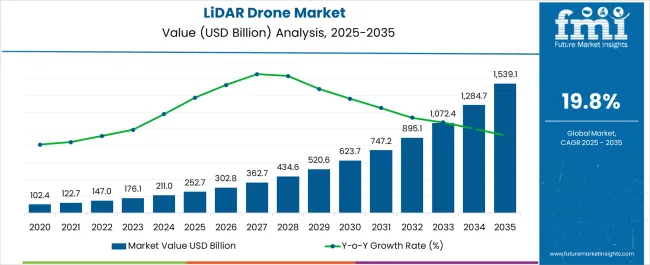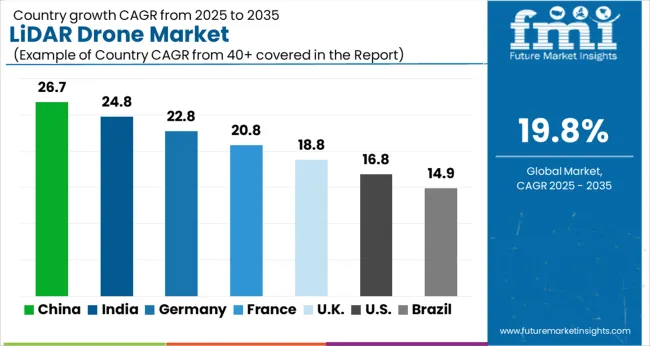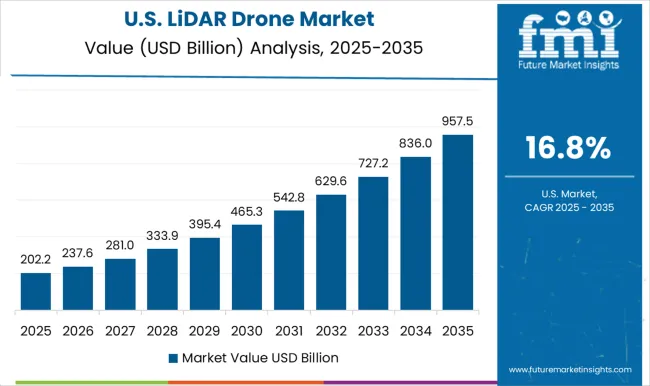The LiDAR Drone Market is estimated to be valued at USD 252.7 billion in 2025 and is projected to reach USD 1539.1 billion by 2035, registering a compound annual growth rate (CAGR) of 19.8% over the forecast period.

| Metric | Value |
|---|---|
| LiDAR Drone Market Estimated Value in (2025 E) | USD 252.7 billion |
| LiDAR Drone Market Forecast Value in (2035 F) | USD 1539.1 billion |
| Forecast CAGR (2025 to 2035) | 19.8% |
The LiDAR drone market is gaining strong momentum as industries increasingly adopt advanced aerial mapping and surveying solutions. Rising demand for accurate geospatial data across construction, mining, forestry, and environmental monitoring has accelerated adoption of LiDAR equipped drones.
The ability of drones to capture high resolution, three dimensional data in challenging terrains has enhanced operational efficiency and reduced project costs. Continuous advancements in sensor miniaturization, battery performance, and integration with AI driven analytics are supporting broader deployment.
Regulatory frameworks favoring the use of drones for commercial purposes have also contributed to adoption. The outlook remains favorable as enterprises seek scalable and cost effective surveying tools that provide real time, actionable insights and support the transition toward digital infrastructure and precision resource management.
The topographic LiDAR segment is projected to account for 57.30% of total market revenue by 2025 within the LiDAR type category, establishing it as the leading segment. Its dominance is attributed to its ability to deliver high accuracy elevation models that are critical for construction planning, infrastructure development, and environmental management.
The segment benefits from increased investments in smart city projects and large scale transportation networks where detailed terrain mapping is essential.
Topographic LiDAR’s versatility in diverse applications, ranging from flood modeling to vegetation management, continues to reinforce its market leadership.
The LiDAR lasers component is expected to hold 62.80% of total revenue by 2025 within the component category, positioning it as the most significant segment. This growth is driven by the essential role of lasers in ensuring precision, range, and accuracy in data capture.
High performance lasers enable better penetration through vegetation and improve measurement reliability in complex terrains. Continuous innovations in laser technology that enhance efficiency, range, and durability are further supporting their adoption.
As accuracy and data quality remain the key differentiators in drone based surveying, LiDAR lasers continue to represent the core of system performance.
The LiDAR lasers component is expected to hold 62.80% of total revenue by 2025 within the component category, positioning it as the most significant segment. This growth is driven by the essential role of lasers in ensuring precision, range, and accuracy in data capture.
High performance lasers enable better penetration through vegetation and improve measurement reliability in complex terrains. Continuous innovations in laser technology that enhance efficiency, range, and durability are further supporting their adoption.
As accuracy and data quality remain the key differentiators in drone based surveying, LiDAR lasers continue to represent the core of system performance.
As per Future Market Insights (FMI), global sales of LiDAR drones increased at a CAGR of 27.7% from 2020 to 2024. For the assessment period (2025 to 2035), LiDAR drone demand will accelerate at 19.8% CAGR. This will create an absolute $ opportunity of USD 1539.1 million by the end of 2035.
LiDAR drones are used in agriculture, accident incidents, archaeology, mining, forestry, insurance, and inspection applications. These drones use ultraviolet lights and thus can be used during nights as well when the light available is poor.
They can easily capture and produce accurate 3D maps of the places they are sent to scan and give us minute details of the place. This helps in gathering exact information about the places where accidents have taken place and can help in sending necessary help during an emergency.
Exact depiction of accident places can be done using such drones and such evidence can be used in courts to show the potential reasons and impacts of accidents.
Drones, specifically LiDAR drones, are extensively being used in the mining industry to make the workflow smooth and avoid accidents. For instance, in August 2025, Central Mining Planning and Design Institute (CMPDI) announced that they have started to assess the wider rollout of drones in their mining operations.
The underground fires and waterlogging which have been common issues in this industry will be tackled by the use of drones. Besides, with the usage of drones, analysis of situations through the high-resolution photographs taken by drones will further enable the authority to make wise decisions.
CMPDI also mentioned that they have recently purchased two drones for surveillance, with the presence of mines with over 600 million coal production per year. The adoption of LiDAR drones by CMPDI and other mining companies is likely to swell in the next ten years.
Growing applications in archaeological research will elevate LiDAR drone demand during the assessment period. LiDAR drones are being increasingly utilized during archaeological research and surveys due to their efficient nature.
For instance, in August 2025, a group of 14 students of Embry-Riddle Aeronautical University that went to New Mexico and Arizona to work with archaeologists in mapping ancient cities, used drones to map- locations that were inhabited 4000 years ago.
The students’ team identified a reservoir system and prehistoric canals, which are believed to support a population of nearly 10,000 in Safford, Arizona. They searched for irrigation systems and farmlands near Tularosa, which was inhabited from 450 A.D. to 650 A.D.
Man’s growing desire to search for locations that used to exist hundreds of years ago will act as a catalyst triggering LiDAR drone sales through 203.2 Besides, increasing applications in agriculture industry will create lucrative opportunities for LiDAR drone manufacturers.
Laser technology is used in LiDAR drones. In comparison to photogrammetric systems, laser technology is expensive. Photogrammetric systems are easily available and are of low cost.
For instance, a photogrammetric system costs USD 20 to 30K and on the other hand, the manned LiDAR drone costs nearly USD 150K, whereas an unmanned LiDAR drone costs from USD 145K to USD 180K.
Hence, rising popularity of photogrammetric system drones due to their low cost will act as an impediment to the expansion of LiDAR drones’ industry.
Besides this, strict rules and regulations governing the usage of drones and lack of skilled professionals are negatively influencing the market.

| Country | United States |
|---|---|
| Projected CAGR (2025 to 2035) | 17.9% |
| Historical CAGR (2020 to 2024) | 24.8% |
| Market Value (2035) | USD 1539.1 million |
| Country | United Kingdom |
|---|---|
| Projected CAGR (2025 to 2035) | 18.8% |
| Historical CAGR (2020 to 2024) | 26.1% |
| Market Value (2035) | USD 41.4 million |
| Country | China |
|---|---|
| Projected CAGR (2025 to 2035) | 20.8% |
| Historical CAGR (2020 to 2024) | 29.5% |
| Market Value (2035) | USD 73.9 million |
| Country | Japan |
|---|---|
| Projected CAGR (2025 to 2035) | 19.1% |
| Historical CAGR (2020 to 2024) | 26.8% |
| Market Value (2035) | USD 62.4 million |
| Country | South Korea |
|---|---|
| Projected CAGR (2025 to 2035) | 20.2% |
| Historical CAGR (2020 to 2024) | 28.6% |
| Market Value (2035) | USD 34.8 million |

Heavy Presence of LiDAR Drone Companies Boosting the USA Market
The United States lies at the center stage of LiDAR drone revenue growth. As per Future Market Insights, the United States LiDAR drone market size will reach USD 1539.1 million by 2035.
Overall LiDAR drone sales across the USA are forecast to rise at 17.9% CAGR through 2035. Between 2025 and 2035, the United States market is set to create an absolute $ opportunity of USD 102.4 million. The USA LiDAR drone market expanded at a CAGR of 24.8% from 2020 to 2025.
Rising application of LiDAR drones in mining, agriculture, inspections, law enforcement, and archaeology is driving the United States market.
Large presence of leading LiDAR drone manufacturing companies is also boosting the USA market. The United States is home to companies such as Velodyne Inc., LIDARUSA, Phoenix LiDAR systems, and GeoCue Group which are doing research and development in commercial UAV LiDAR mapping solutions, drones mounting on multi-platforms such as aircraft and vehicles.
Besides this, several start-ups are showing inclination towards entering this market due to increasing demand for LiDAR technology from various fields.
Rotary Wing Drone Remains Top Selling Type
As per the drone type, demand for rotary-wing drones is likely to remain high in the global market. FMI predicts rotary wing LiDAR drone segment to expand at 19.7% CAGR through 2035. Between 2020 and 2024, rotary-wing LiDAR drone demand grew at 27.6% CAGR.
Rising adoption of rotary wing drones due to their several advantages is driving growth of the target segment. Generally, a rotary wing drone has 4 rotors and these rotors help in controlling the motion of the drone using propellers. This gives rotary-wing drones an edge over fixed-wing to land in any area and helps in maneuverability.
Rotary wing drones are also cost-effective as compared to fixed wing LiDAR drones. For instance, cost of fixed wing drone is around USD 250,000 whereas a rotary wing drone costs around USD 100,000.
Thus, such cost- effective rotary-wing drones are essential in surveillance of mining and agricultural industries where drones are required to fly at lower heights and work in a confined area.
Key advantages of rotary-wing drones
Take less time to set up, take off, and land
Topography LiDAR to be the Most Lucrative Type
Topographic LiDAR drones are expected to remain the most lucrative type through 2035. Topographic LiDAR segment witnessed a CAGR of 27.5% from 2020 to 2024. Between 2025 to 2035, it will expand at 17.6% CAGR.
Topographic LiDAR drones are used in mining work, civil engineering, road operations, road construction, and corridor mapping. This type of LiDAR is the most revenue-generating segment because of its applications in mining, agricultural and road-transport industries.
Topographic LiDAR drones have an edge over bathymetric LiDAR drones as they can cover large land areas. Thanks to this feature, they are used in urban planning and geomorphology.
Topographic LiDAR is useful to map surface terrain, whether it’s mountain ranges, forests, or cityscapes For instance, In October 2025, in Bia?owie?a forest in Poland, more than 800 ancient monuments were found using Topographic LiDAR Drones. The survey was conducted by a team of scientists and archaeologists from the Institute of Archaeology of Cardinal Stefan Wyszynski University in Warsaw.

Key LiDAR drone companies operating in the market include SZ DJI Technology company ltd, Velodyne LiDAR Inc, Phoenix LiDAR Systems, Teledyne Optech, Sick AG, Trimble Navigation Ltd, Leica Geosystems AG, Faro Technology, and Riegl Measurement System.
New product launches with innovative designs and intensive research and development activities are key strategies adopted by companies. Besides this, leading LiDAR drone manufacturers are using merger and collaboration strategy to gain an upper hand in the market.
Recent Developments
| Attribute | Details |
|---|---|
| Estimated Market Size (2025) | USD 252.7 billion |
| Projected Market Size (2035) | USD 1539.1 billion |
| Anticipated Growth Rate (2025 to 2035) | 19.8% CAGR |
| Forecast Period | 2025 to 2035 |
| Historical Data Available for | 2020 to 2024 |
| Market Analysis | USD Million for Value and MT for Volume |
| Key Regions Covered | North America; Latin America; Europe; Asia Pacific; and the Middle East & Africa |
| Key Countries Covered | United States, Canada, Brazil, Mexico, Germany, United Kingdom, France, Italy, Spain, Nordic, Russia, Poland, China, India, Thailand, Indonesia, Australia and New Zealand, Japan, GCC countries, North Africa, South Africa, and others. |
| Key Segments Covered | LiDAR Type, Components, Drone Type, Range, Application, and Region |
| Key Companies Profiled | Phoenix LiDAR Systems; Teledyne Optech; Velodyne LiDAR Inc; SZ DJI Technology company ltd; Sick AG; Trimble Navigation Ltd; Faro Technology; Riegl Measurement System; Leica Geosystems AG; 3D Robotics Inc; MicroDrones |
| Report Coverage | Market Forecast, Company Share Analysis, Competition Intelligence, Drivers Restraints Opportunity Trends Analysis, Market Dynamics and Challenges, and Strategic Growth Initiatives |
The global lidar drone market is estimated to be valued at USD 252.7 billion in 2025.
The market size for the lidar drone market is projected to reach USD 1,539.1 billion by 2035.
The lidar drone market is expected to grow at a 19.8% CAGR between 2025 and 2035.
The key product types in lidar drone market are topographic and bathymetric.
In terms of components, lidar lasers segment to command 62.8% share in the lidar drone market in 2025.






Full Research Suite comprises of:
Market outlook & trends analysis
Interviews & case studies
Strategic recommendations
Vendor profiles & capabilities analysis
5-year forecasts
8 regions and 60+ country-level data splits
Market segment data splits
12 months of continuous data updates
DELIVERED AS:
PDF EXCEL ONLINE
LiDAR in Mapping Market Size and Share Forecast Outlook 2025 to 2035
1550nm LiDAR Pulsed Fiber Laser Market Forecast and Outlook 2025 to 2035
Mobile LiDAR Scanner Market Size and Share Forecast Outlook 2025 to 2035
Radar & LiDAR Technology for Railways - Trends & Forecast 2025 to 2035
Solid State LiDAR Sensor Market Analysis Size and Share Forecast Outlook 2025 to 2035
Boundary Layer Wind Lidar Market Size and Share Forecast Outlook 2025 to 2035
Drone Test Stand Market Size and Share Forecast Outlook 2025 to 2035
Drone Simulator Market Size and Share Forecast Outlook 2025 to 2035
Drones For Emergency Responders Market Size and Share Forecast Outlook 2025 to 2035
Drone Inspection and Monitoring Market Size and Share Forecast Outlook 2025 to 2035
Drone Cybersecurity Market Size and Share Forecast Outlook 2025 to 2035
Drone Logistics & Transportation Market Size and Share Forecast Outlook 2025 to 2035
Drone Warfare Market Size and Share Forecast Outlook 2025 to 2035
Drone Analytics Market Size and Share Forecast Outlook 2025 to 2035
Drone Battery Market Size and Share Forecast Outlook 2025 to 2035
Drone Delivery Service Market Analysis by Delivery Distance, Propeller Type, End User, and Region, and Forecast from 2025 to 2035
Drone Sensor Market - UAV Advancements & Forecast 2025 to 2035
Drone Motor Market Growth - Trends & Forecast 2025 to 2035
Toy Drones Market Size and Share Forecast Outlook 2025 to 2035
Anti-Drone Technology Market

Thank you!
You will receive an email from our Business Development Manager. Please be sure to check your SPAM/JUNK folder too.
Chat With
MaRIA